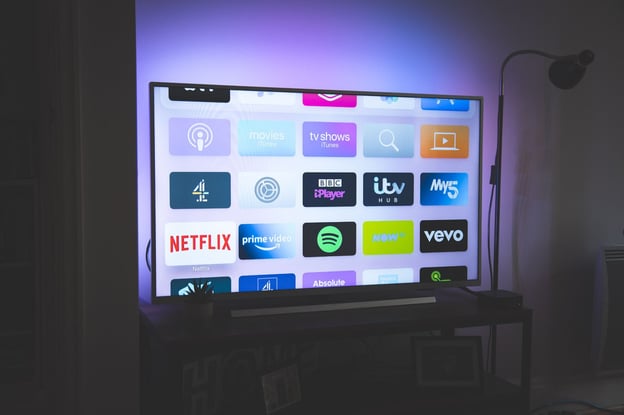This article answers the question, “What is CTV advertising?”, with additional information about how it works and why it’s growing.
Consumer migration away from traditional TV viewing is creating an exciting opportunity for marketers

Connected TV (CTV) advertising is rapidly becoming a crucial pillar of marketing and not just for the traditional TV advertiser we are accustomed to seeing in Super Bowl ads and “Prime Time” TV. Consider the following: 164 million US users currently access video on CTV devices, with more expected to make the migration from traditional TV in the next year. 81% of respondents to a survey about viewing habits said they prefer free, ad-supported streaming over paying for another subscription. Small wonder, given that the average North American viewer already uses more than eight streaming services on a regular basis. The potential reach of CTV advertising is massive, and yet it’s still relatively new territory for many marketers.
It’s time, then, for an introduction to CTV marketing.
What is CTV advertising?
CTV advertising is advertising run on any CTV device, which is to say any device designed to support streaming multimedia content and connect to the internet. CTV stands for “connected TV”, i.e. one that is connected to the internet.
The connected tv advertising definition becomes ambiguous thanks to the term OTT (over the top). The term CTV is often used interchangeably with OTT, which can lead to confusion as they’re related, but not the same. OTT comprises the multimedia content that is streamed to the CTV device. The term CTV is also sometimes used interchangeably with “smart TV,” but smart TVs are a subset of the broader CTV category. So, to sum up, CTV is the television, and OTT is content which may be accessed through any number of devices (television, mobile phones, tablets, laptops, etc.). Netflix and Hulu are therefore two of the best-known sources of OTT content, and Roku is one of the best-known CTV devices.
How does CTV advertising work?
Broadly speaking, CTV advertising works the same way other digital advertising does, with ads being sold and bought via auction. As a quick reminder, the media buying ecosystem has several levels of auctions, with each tier having its own parameters of price and access. Connected TV advertising transactions often take place on an invite-only private marketplace (PMP), which exists one level above the open ad marketplace.
The rarified air of the PMP often comes at a high-priced minimum CPM, though this is not always the case. The value of a PMP is that it provides access to inventory and creative formats that may not be available in an open auction environment. It also typically has fewer bidders, leading to higher win rates.
It’s important to understand how attribution on CTV differs from both other digital advertising and ads on linear tv. Typically, the progression is as follows:
- An ad is delivered to the CTV advertising platforms in a household, identifying and storing the household’s IP address in an exposure file.
- A device graph is used to understand which additional devices in the household are connected to the same IP address. These devices are added to the exposure file.
- A member of the household uses one of the connected devices to complete the advertiser’s desired advertiser action, such as making a purchase.
- Data on the outcome event is recorded via a pixel and stored in an outcome file.
- The information in exposure files is compared to that in outcome files, identifying IP matches.
- IP matches are attributed and recorded.
The attribution and targeting that CTV advertising platforms are capable of simply isn’t possible on linear TV. This is because linear TV is bought and measured using panels, indexes, and samples, while CTV is 1:1.
What’s a connected TV advertising example?
CTV ads can come in a variety of creative formats, including display, video, and audio. Typically, advertisers take advantage of CTV platforms’ capabilities — and account for their limitations — by designing creative with particularly engaging video or audio components. The most common kinds of CTV ads are:
- In-stream: An unskippable full-screen video, typically 15-30 seconds, that plays before or during the program.
- Interactive pre-roll (or mid-roll): Similar to in-stream ads, except viewers can click through to a landing page.
- Home screen: Ads that display on, you guessed it, a streaming service’s home screen. They’re usually a short video or static image with a CTA such as “Learn More.”
Want to learn more? Our CTV Advertising Playbook gives thorough insight into what kind of CTV ads will perform best for your audience. Download your free copy and get started:
Benefits of CTV advertising
We’ve already touched on the massive audience consuming CTV content on a daily basis, and their overwhelming preference to watch ad-supported streaming over paid subscriptions. That’s just the starting point for exploring the benefits of CTV advertising, though. Other benefits include:
- Expanded reach without increased cost — The majority of OTT content is viewed on a television, and is therefore likely to be seen by more than one person. While a single ad served on a phone or laptop is typically only reaching one person; on CTVs it’s reaching an entire household.
- Increased VCR — The video completion rate for CTV advertising is as high as 95%. VCR on other platforms hovers around 80%.
- Receptive audience — Consumers believe CTV advertising does a better job of marketing to them than ads on traditional TV. 49% say CTV ads provide more relevant content than ads on TV or cable.
- Highly engaged audience — Viewers who are emotionally invested in a program tend to remember the ads shown during it. A Twitter Social TV Lab study showed a 48% higher ad recall for shows that elicited emotional responses.
- Precision targeting — As mentioned earlier, OTT consumers have multiple streaming services, providing CTV advertisers with more opportunities to collect valuable targeting data. This increases if the creative is designed to work with another device, such as a TV ad including a QR code meant to be accessed via mobile phone. The first- and third-party data collected from connected TV advertising can be used to target a specific household or even an individual within that household.
- Attribution: CTV’s deterministic 1:1 attribution model provides unambiguous insight into ad performance.
CTV performance metrics
The metrics used to evaluate the effectiveness of connected TV advertising are similar to those for traditional online advertising. The most frequently used performance metric is therefore cost per completed view (CPCV). The most comment performance metrics are return on ad spend (ROAS), cost per acquisition (CPA), average order value (AOV), and so forth. All buying is done via CPM, or in some cases CPA.
An ongoing challenge with measuring CTV ad performance is attribution, which is why advertisers typically enlist the help of a highly experienced partner. tvScientific’s CTV buying and attribution platform gives advertisers full control over their campaigns with advanced measurement and attribution tools. tvScientific is the first CTV advertising platform that combines the power of television with the performance of digital marketing. To learn more about how tvScientific can help you participate in the new world of performance TV, get in touch.








